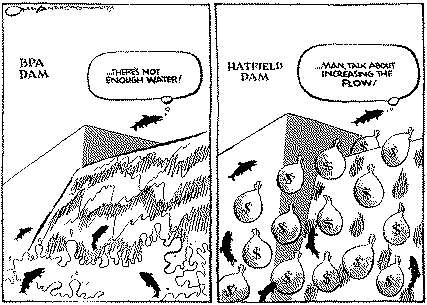![]()
The focus on survival of juvenile salmon is a relatively recent phenomenon. Biologists recognized decades ago that the primary problem likely to be caused by the dams was that the adults returning to the spawning grounds could not ascend them. As Bonneville Dam was constructed, controversy raged as to whether its fish ladders would work. As one writer observed, "noted scientists who have studied the situation claim it is extremely important that the salmon find the big stairways with an absolute minimum of delay. Salmon on their way to spawn have only a limited amount of energy. They never eat from the time they enter fresh water from the sea until they die high in the mountains after breeding. If the female salmon, each carrying from twenty-five hundred to five thousand eggs, spend their strength fighting the dam, they will not be able to ascend the long series of pools when they finally discover them. The men building the dam are aware of this."81 Fortunately, the fish ladders were an enormous success.
At the time, effects on juvenile salmon were neglected. Now the pendulum has swung, and the effects on adults are ignored. The lack of focus on adults seems to be a byproduct of having harvest agencies in charge of protecting endangered salmon: once the salmon reach harvestable size, the agencies’ conflict of interest becomes overpowering. Juvenile Snake River salmon are protected as endangered, but adults are caught and sold for food. The fishery agencies consistently refuse to evaluate the effects of their efforts to improve dam passage for juveniles on the returning adults, probably because in most cases they are making things worse for adults.
A picture is worth a thousand words, and the problem that flow augmentation poses for adults is best illustrated by a cartoon that appeared in The Oregonian:

Figure 4: Oregonian Cartoon82
What is wrong with this picture? Put yourself in the salmon's place. The salmon is trying to swim against a raging torrent of water. The last thing in the world the salmon could possibly be thinking is that it needs a stronger current to swim against. This cartoon illustrates the remarkable degree to which worship of flow has displaced rational thought in fisheries management (and the media).
Fishermen have long recognized that “[i]n order to conserve energy in their upstream passage, salmon tend to ‘sound’ or move to the bottom of the river where the current is not so strong, especially during the ebb tide and during periods of freshet”.83 Scientific studies confirm that the progress of returning adult salmon up the Columbia River is impeded by higher flows. Delays of up to several days at each dam from higher flows are well documented.
As Dr. William McNeil has explained,
“Summer chinook and sockeye exhibit delayed passage time at high flow along with spring chinook. Sustained upstream movement against river currents and possible delays in locating ladders at dams places demands on finite energy reserves. Adult salmon fast during their spawning migration, and expended energy is not replaced. Artificially increasing water velocity through flow augmentation and/or reservoir drawdown is likely to delay migration of spring and summer chinook and sockeye spawners.”84
As Dr. McNeil points out, the adverse effects would be strongest on the endangered “Snake River spring chinook salmon which migrate the farthest distance from the ocean to reach spawning grounds”.85
Dr. McNeil suggests that “it remains to be determined whether prespawning survival is compromised” as a result of the delays”.86 Fishery agencies have long blamed the dams for delaying adults and causing salmon mortality, going so far as to claim that “[d]elays of three to four days often killed the fish”.87 The U.S. Army Corps of Engineers estimates that some of the “natural river” drawdown plans under consideration would increase adult travel time from 10-30%.88 Thus if the fishery agencies were consistent, they would have to state that dam removal or reservoir drawdown would decimate adult salmon.
As a matter of elementary population biology, each returning adult is literally thousands of times more important to the perpetuation of the species than one of the thousands of juvenile salmon heading downstream. Adults returning up the Columbia River have survived anywhere from 2 to 6 years of competition in the river, the estuary and the open ocean. They have run a gauntlet of predators, both human and animal. They are returning with thousands of eggs to deposit in the spawning grounds. Without success in returning these adults to the spawning grounds, salmon populations cannot hope to recover.
Flow augmentation has also caused extraordinary adverse effects on the fish and wildlife in the reservoirs drained to provide flows. Chapter 11 discusses the effects in the reservoir behind Dworshak Dam in Northern Idaho. Similar if not worse effects are found in reservoirs in Montana which have been drained for flow augmentation.89
It ought to be shocking that since 1980, the largest single component of the $3 billion or more spent on salmon restoration has gone to increase flows, yet we do not know one of the most basic facts necessary to tell whether or not these flows help: whether benefits to juveniles (if any) outweigh known adverse effects on adults. How this came about is, in part, a product of what passes for “law” in salmon recovery.
82 The Oregonian, Sept. 24, 1995. Jeff Ohman, the cartoonist, graciously agreed to let me reprint his work
83 I. Martin, Legacy and Testament: The Story of the Columbia River Gillnetters 25 (WSU Press 1994).
84 W. McNeil, “Timing of Passage of Adult Salmon and Steelhead at Columbia Basin Dams”, May 17, 1993, at 6.
87 J. Cone, A Common Fate 127 (citing unspecified assertions of the “Fisheries Service”).
88 U.S. Army Corps of Engineers, "Interim Status Report", at ES-13.
89 See, e.g., ISG, Return to the River 265.
This Web page was created using a Trial Version of HTML Transit 3.0.